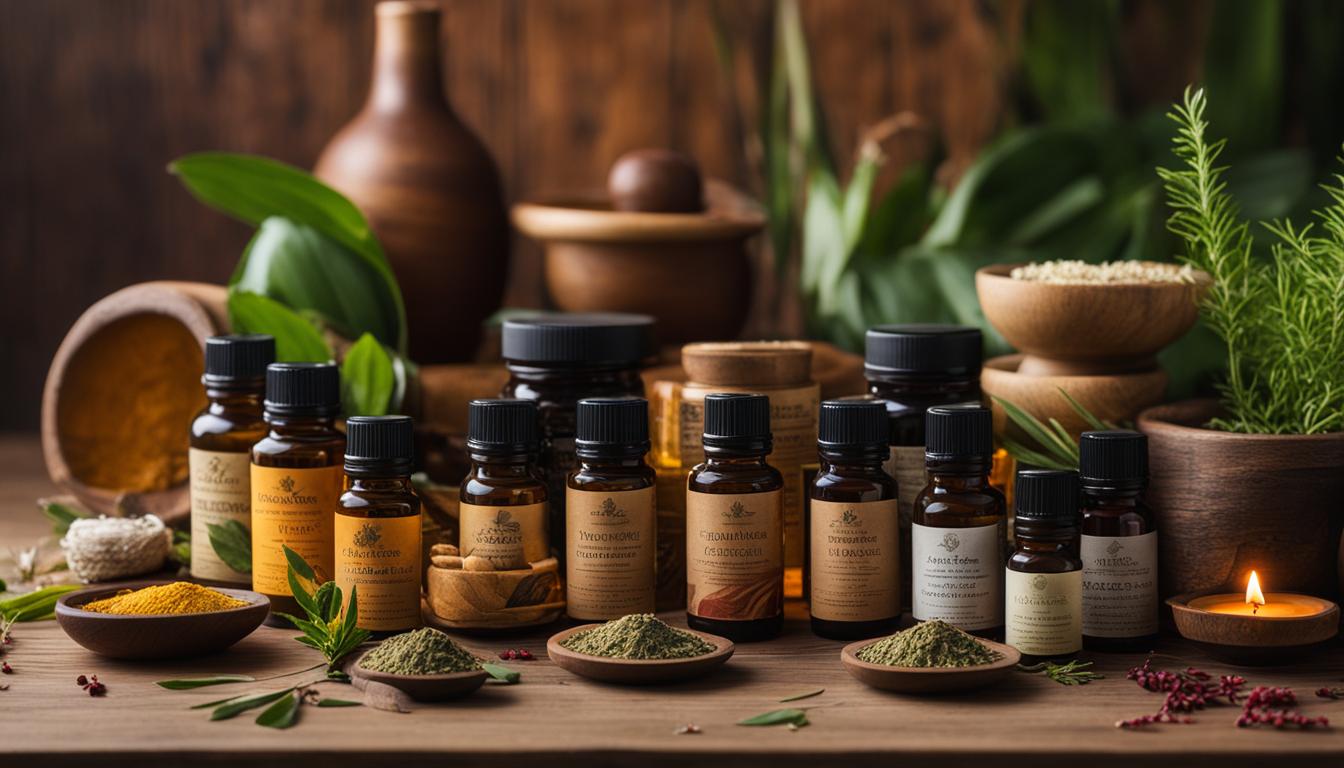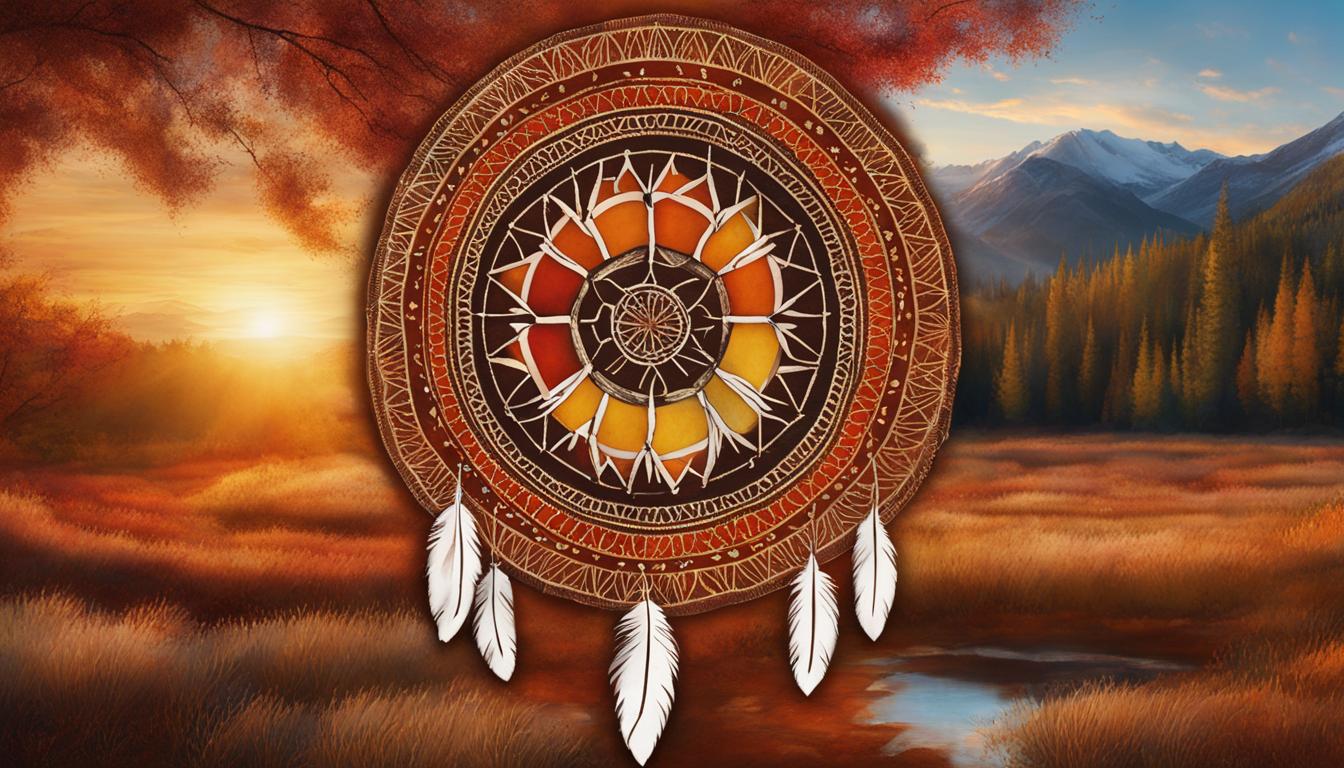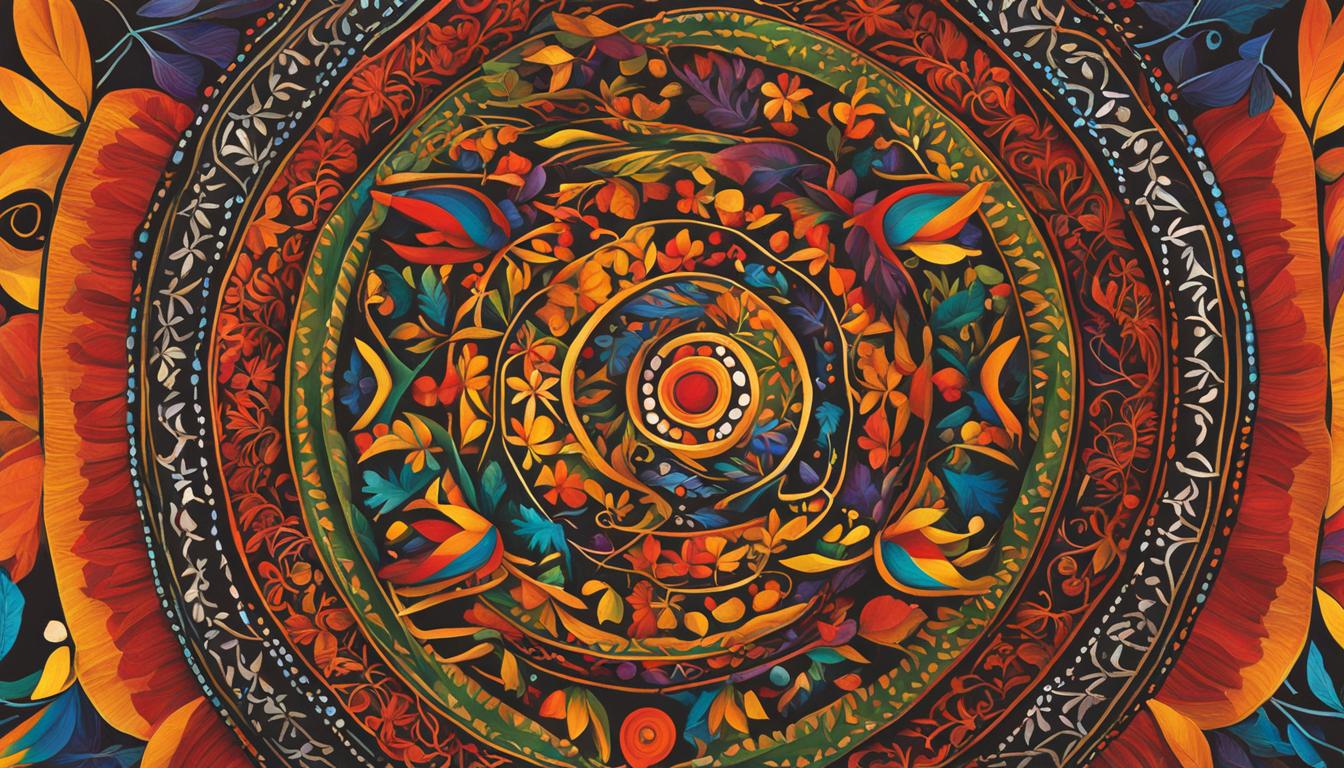Join us as we explore the realm of Indigenous health and wellness choices, where we pay tribute to the influence of ancestral healing traditions and embrace comprehensive approaches to health that have been passed down through generations. The link between Indigenous culture and well-being is profound, recognizing the substantial effects of the environment, sea, traditions, and spiritual practices on health. In a time where holistic health is increasingly valued, it is crucial to uphold and honor the distinct needs and traditions of Indigenous communities.
From traditional medicine to indigenous wellness products, this article delves into the cultural health practices that contribute to Indigenous well-being. Together, we will explore the richness of traditional wellness methods and learn from the wisdom of Indigenous cultures. Join us on this journey as we uncover the deep connections between Indigenous culture and wellness, and discover the top picks for embracing indigenous health practices.
Key Takeaways:
- Indigenous health and wellness are rooted in traditional healing practices and holistic approaches to well-being.
- Social and emotional well-being is a key aspect of Indigenous health, and it is crucial to address the distinct needs of individuals in Indigenous communities.
- The National Agreement on Closing the Gap in Australia prioritizes social and emotional well-being, with specific targets monitored annually.
- Understanding social and emotional well-being requires recognizing the collectivist approach and the influence of culture, spirituality, and historical factors. It is distinct from mental health problems and mental illness.
- The First Nations perspective of health emphasizes the holistic concept of well-being and the importance of cultural understanding, human rights, and Aboriginal strengths.
Understanding Social and Emotional Wellbeing
Social and emotional wellbeing is a fundamental aspect of Indigenous health and plays a pivotal role in holistic wellness. It encompasses the interconnectedness of individuals, their families, and their communities, considering the influence of culture, spirituality, and historical, social, and political factors on overall wellbeing.
It is important to recognize that social and emotional wellbeing is distinct from mental health problems and mental illness. While they can interact and influence each other, social and emotional wellbeing focuses on the collective experience of individuals within cultural groups and their individual experiences within those groups.
To provide comprehensive care for Aboriginal and Torres Strait Islander communities, addressing social and emotional wellbeing alongside mental health is crucial. By doing so, we can support the social, emotional, and cultural needs of individuals and facilitate their journey towards optimal health.
“Social and emotional wellbeing is not just the absence of illness or disease; it is about supporting individuals to flourish and thrive within their cultural contexts.”
Understanding the distinctive aspects of social and emotional wellbeing is essential for healthcare professionals, policymakers, and communities to develop targeted and culturally appropriate interventions that promote community health and wellbeing. By acknowledging the complex interplay between an individual’s social, emotional, and cultural factors, we can foster resilience, enhance connectedness, and empower individuals within their communities.
The Influences on Social and Emotional Wellbeing
Social and emotional wellbeing is deeply influenced by Aboriginal and Torres Strait Islander cultural traditions, values, and practices. It is necessary to address the historical and ongoing impacts of colonization, dispossession, and marginalization that have affected Indigenous communities.
This collective approach to wellbeing recognizes the importance of cultural identity, self-determination, and community support. It acknowledges the role of spirituality, kinship systems, and cultural knowledge in promoting positive mental and emotional health within Aboriginal and Torres Strait Islander communities.
The Five Key Dimensions of Social and Emotional Wellbeing
Aboriginal and Torres Strait Islander social and emotional wellbeing is divided into five key dimensions that encapsulate various aspects of individual and collective wellbeing:
| Dimension | Description |
|---|---|
| Physical | Focuses on the physical health and vitality of individuals and communities. |
| Cultural | Emphasizes the importance of cultural identity, connection to traditional lands, and the preservation of Indigenous languages, art, and customs. |
| Spiritual | Encompasses the beliefs, practices, and ceremonies that allow individuals to connect with their spirituality, ancestors, and the natural world. |
| Mental | Addresses psychological and emotional wellbeing, including the ability to manage stress, develop coping mechanisms, and maintain positive mental health. |
| Social | Highlights the importance of social relationships, community engagement, and connection to family, friends, and peers. |
These dimensions work together synergistically to create a comprehensive framework for understanding and addressing the social and emotional wellbeing of Aboriginal and Torres Strait Islander peoples. By considering and supporting each dimension, healthcare providers and communities can promote holistic health and contribute to the overall wellbeing of Indigenous individuals.

As we continue to learn and grow in our understanding of social and emotional wellbeing, it is crucial to foster culturally safe practices, enhance community support networks, and prioritize the diverse needs and experiences of Aboriginal and Torres Strait Islander communities. By doing so, we can create a society that values and supports the holistic health and wellbeing of all its members.
The First Nations Perspective of Health
The First Nations perspective of health recognizes that health is not simply the absence of illness but a holistic concept that encompasses physical, mental, emotional, and spiritual well-being. This perspective acknowledges the interconnectedness of these different aspects of health and their impact on overall well-being.
Aboriginal Community Controlled Health Organisations (ACCHOs) have played a pivotal role in shaping the First Nations perspective of health in Australia. These organizations are community-governed and provide comprehensive primary health care services to Aboriginal and Torres Strait Islander people, taking into account their cultural understanding and needs. ACCHOs emphasize the importance of cultural knowledge, cultural understanding, and the recognition of human rights in delivering holistic health care.
The First Nations perspective of health recognizes the strengths and resilience of Aboriginal and Torres Strait Islander communities. It acknowledges the cultural diversity within these communities and the importance of preserving and promoting cultural practices and traditions as part of holistic health care.
Guiding Principles for Social and Emotional Wellbeing
The framework for Aboriginal and Torres Strait Islander Peoples’ Mental Health and Social and Emotional Wellbeing provides guiding principles that underpin social and emotional wellbeing in indigenous communities:
- Recognition of culture and cultural diversity
- Recognition of the impact of history and trauma
- Recognition of human rights
- Recognition of the importance of holistic approaches to health
- Recognition of the importance of social and emotional wellbeing as a key determinant of health
These principles serve as a foundation for understanding and addressing social and emotional wellbeing from a First Nations perspective, ensuring that health care is respectful, inclusive, and culturally appropriate.
| Principle | Description |
|---|---|
| Recognition of culture and cultural diversity | Embracing and respecting the diverse cultural practices, languages, and customs of Aboriginal and Torres Strait Islander communities. |
| Recognition of the impact of history and trauma | Acknowledging the historical and intergenerational impacts of colonization, dispossession, and racism on the health and well-being of Indigenous peoples. |
| Recognition of human rights | Respecting and promoting the human rights of Aboriginal and Torres Strait Islander peoples, including their right to self-determination and control over their own health and well-being. |
| Recognition of the importance of holistic approaches to health | Treating health holistically by addressing physical, mental, emotional, and spiritual well-being. |
| Recognition of the importance of social and emotional wellbeing as a key determinant of health | Understanding that social and emotional well-being is interconnected with physical health and is central to achieving overall health and well-being. |
The First Nations perspective of health and the principles outlined by the framework for Aboriginal and Torres Strait Islander Peoples’ Mental Health and Social and Emotional Wellbeing ensure that indigenous communities are approached with cultural sensitivity, respect, and a commitment to promoting holistic health and well-being.
The National Strategic Framework for Aboriginal and Torres Strait Islander Peoples’ Mental Health and Social and Emotional Wellbeing
The National Strategic Framework for Aboriginal and Torres Strait Islander Peoples’ Mental Health and Social and Emotional Wellbeing is a comprehensive model that recognizes the interconnectedness of social and emotional wellbeing with various domains of life. This framework aims to promote the well-being and resilience of First Nations individuals by addressing the unique needs and challenges they face.
The framework identifies seven overlapping domains that contribute to social and emotional wellbeing:
- Body, Mind, and Emotions
- Family and Kin
- Community
- Culture
- Country
- Spirituality
- Ancestors
Each of these domains plays a crucial role in shaping the social and emotional wellbeing of Aboriginal and Torres Strait Islander Peoples. By considering these overlapping domains, the framework acknowledges the impact of history, politics, society, and culture on the well-being of Indigenous communities.
The National Strategic Framework encourages a holistic approach to health and wellness that encompasses physical, mental, emotional, and spiritual aspects. By recognizing the importance of these interconnected domains, the framework promotes a strong and positive First Nations identity, fostering a sense of belonging and well-being.
“The National Strategic Framework for Aboriginal and Torres Strait Islander Peoples’ Mental Health and Social and Emotional Wellbeing acknowledges the significance of cultural, familial, and community connections in nurturing the well-being of First Nations individuals, thereby fostering resilience and improving health outcomes.”
This framework provides a valuable roadmap for policy development, service provision, and community initiatives aimed at improving the social and emotional wellbeing of Aboriginal and Torres Strait Islander Peoples. By implementing culturally appropriate approaches that address the overlapping domains outlined in the framework, we can support Indigenous communities in their journey towards improved well-being and self-determination.
| Domain | Explanation |
|---|---|
| Body, Mind, and Emotions | Recognizing the interconnectedness of physical, mental, and emotional well-being. |
| Family and Kin | Valuing the importance of strong family connections and supportive relationships. |
| Community | Fostering a sense of belonging and connectedness to the wider community. |
| Culture | Honoring and preserving cultural practices, traditions, and knowledge. |
| Country | Recognizing the significance of the land, sea, and natural environment to well-being. |
| Spirituality | Acknowledging the importance of spiritual beliefs and practices in enhancing well-being. |
| Ancestors | Respecting the wisdom, guidance, and legacy of ancestors in shaping well-being. |
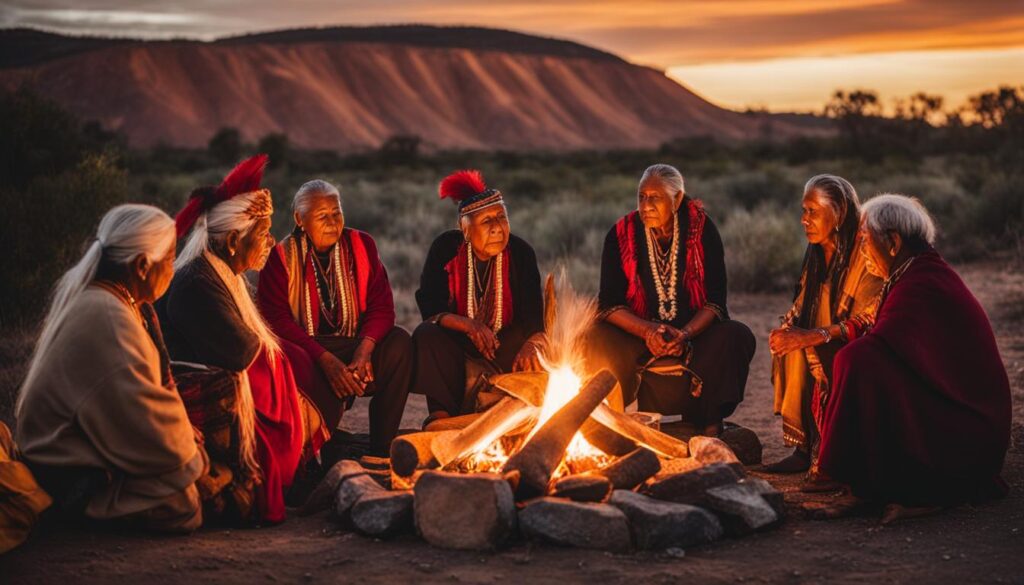
By embracing the National Strategic Framework and its focus on the overlapping domains of social and emotional wellbeing, we can work towards achieving improved health outcomes, promoting resilience, and supporting the holistic well-being of Aboriginal and Torres Strait Islander Peoples.
Key Statistics on Social and Emotional Wellbeing
Data from the National Aboriginal and Torres Strait Islander Health Survey (NATSIHS) 2018-19 provides valuable insights into the social and emotional wellbeing of Indigenous communities. The survey examined psychological distress, mastery, and perceived social support as key indicators of overall well-being. Understanding these statistics can help us tailor appropriate interventions and support systems.
The survey revealed that males in indigenous communities reported higher rates of low/moderate psychological distress compared to females. However, both genders reported similar levels of mastery and perceived social support. These findings highlight the complex nature of social and emotional wellbeing, indicating the importance of addressing specific gender-related needs.
Additionally, the survey underscored the significance of considering geographical location and age. Factors such as remoteness and generational differences can impact social and emotional wellbeing. By acknowledging and accommodating these variations, we can develop targeted strategies that better serve Indigenous individuals across diverse contexts.
| Indicator | Males | Females |
|---|---|---|
| Psychological Distress | Higher rates of low/moderate distress | Comparable rates |
| Mastery | Similar levels | Similar levels |
| Perceived Social Support | Similar levels | Similar levels |
These statistics highlight the importance of understanding the unique social and emotional challenges faced by Indigenous individuals. By tailoring interventions and support mechanisms to address these specific needs, we can contribute to the overall well-being of Indigenous communities.

The Impact of Cultural Engagement on Indigenous Well-Being
Cultural engagement plays a crucial role in promoting the well-being and healthy development of Indigenous youth. Research has shown that when young First Nations individuals are more culturally engaged, they experience higher psychological well-being. Cultural engagement encompasses participating in culturally relevant mentoring, programs, and activities that focus on cultural knowledge and practices.
These initiatives provide opportunities for Indigenous youth to connect with their cultural identity, traditions, and community, ultimately enhancing their well-being. By actively engaging in cultural preservation and traditional practices, young Indigenous individuals develop a deeper sense of cultural pride, belonging, and resilience.
Cultural engagement helps Indigenous youth develop a strong cultural identity, instills a sense of pride in their heritage, and fosters a connection to their traditions. In turn, these elements contribute to their overall well-being and promote positive mental health.
| Cultural Engagement Benefits for Indigenous Youth |
|---|
| 1. Strengthening Cultural Identity |
| 2. Enhancing Sense of Belonging |
| 3. Promoting Cultural Pride |
| 4. Building Resilience |
| 5. Connecting to Traditional Knowledge |
| 6. Fostering Community Involvement |
Cultural engagement programs often create safe and inclusive spaces where Indigenous youth can learn about their traditions, language, and history. By actively participating in these programs, individuals develop a deeper understanding of their cultural heritage and gain valuable skills and knowledge passed down through generations.
Moreover, cultural engagement instills a sense of belonging and connection to the wider Indigenous community. By being part of cultural events, ceremonies, and gatherings, young Indigenous individuals have the opportunity to connect with others who share their heritage. This sense of community and connection contributes to their overall well-being and social support networks.
“Cultural engagement helps Indigenous youth develop a strong cultural identity, instills a sense of pride in their heritage, and fosters a connection to their traditions.”
It is essential to recognize and support the importance of cultural engagement in promoting the well-being of Indigenous youth. By investing in culturally relevant programs and activities, we can empower Indigenous youth to embrace their heritage, preserve their cultural identity, and build a strong foundation for their future.
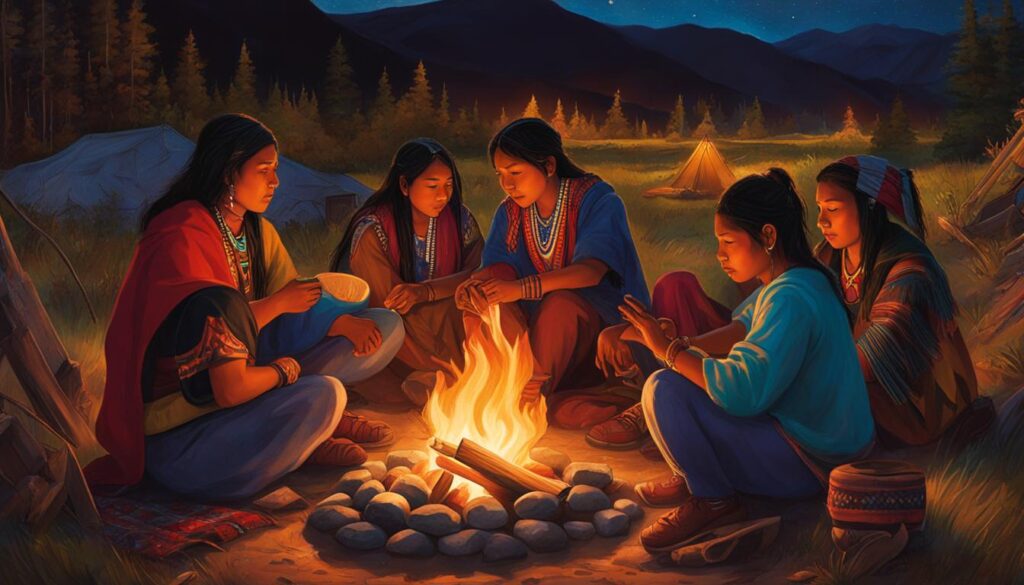
The Importance of Community and Cultural Connection
Engaging with the community and participating in cultural events is essential for Indigenous well-being. These activities provide opportunities for individuals to develop their cultural knowledge, strengthen their cultural identity, and experience a sense of belonging.
By actively engaging in community events, Indigenous people can deepen their connection to their roots, traditions, and customs. This connection not only fosters a sense of pride and identity but also contributes to a stronger sense of belonging and well-being.
Cultural events play a significant role in promoting community engagement and preserving Indigenous cultures. Through these events, a rich tapestry of knowledge is shared and celebrated, allowing individuals to reconnect with their heritage and pass on traditions to future generations.
“Cultural engagement is not only about celebrating who we are but also preserving our traditions, customs, and ways of life. It’s a testament to our resilience and serves as a reminder of the strength and beauty of Indigenous cultures.”
Strengthening Cultural Identity
A vital aspect of community and cultural connection is the reinforcement of cultural identity. By actively participating in cultural events and embracing traditional practices, Indigenous individuals can strengthen their sense of self and reaffirm their cultural identity.
Wearing traditional dress, for example, can have a profound impact on Indigenous well-being. Traditional attire serves as an outward manifestation of cultural pride and identity, allowing individuals to express their heritage and maintain a connection to their ancestors. It serves as a powerful symbol of resilience and belonging.
By valuing and supporting the preservation of Indigenous traditions and practices, communities empower their members to embrace and celebrate their cultural identity, contributing to overall well-being and a strong sense of self-worth.
The Power of Indigenous Resilience
Community and cultural connection are deeply intertwined with Indigenous resilience. Through shared experiences, stories, and cultural practices, communities foster resilience among their members, providing support and strength in the face of adversity.
Indigenous resilience is rooted in the rich history, traditions, and knowledge passed down through generations. Cultural engagement strengthens this resilience by providing a sense of belonging, connection, and purpose.
As Indigenous communities come together to celebrate their cultures, they build a collective resilience that transcends generations. This resilience is instrumental in overcoming challenges, healing from historical trauma, and shaping a brighter future for Indigenous communities.
Cultural Events and Community Engagement
| Benefits | Examples |
|---|---|
| Preservation of cultural knowledge | Language revitalization workshops, storytelling events, traditional cooking demonstrations |
| Strengthening of cultural identity | Cultural dance performances, traditional art exhibitions, traditional music festivals |
| Fostering of community support | Community feasts, intertribal gatherings, community-led initiatives |
| Promoting well-being and resilience | Healing circles, sweat lodge ceremonies, traditional healing practices |
By investing in cultural events and community engagement, we create spaces where Indigenous knowledge, traditions, and resilience can thrive. These initiatives not only foster well-being but also contribute to the preservation and celebration of Indigenous cultures for generations to come.
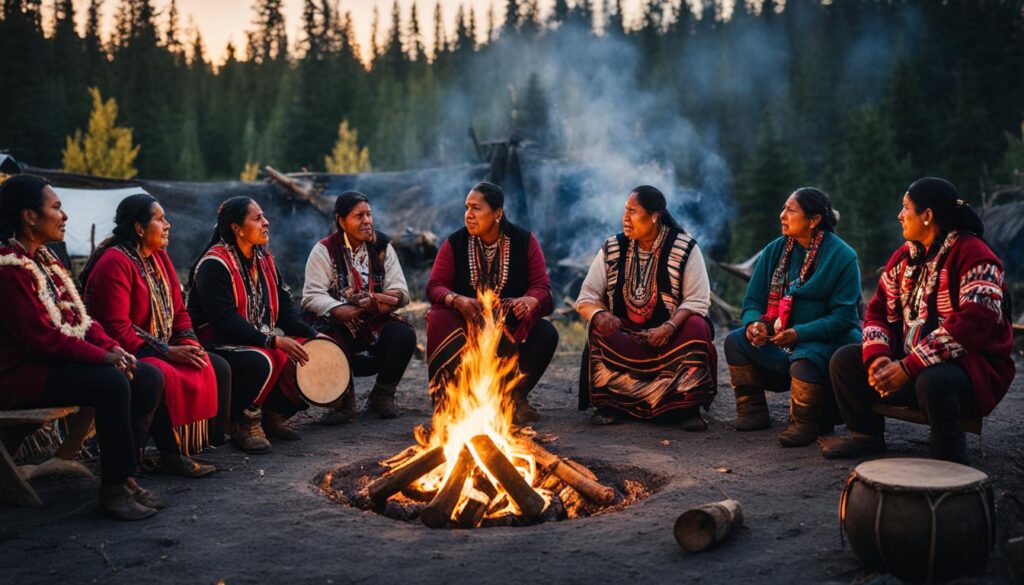
Diverse Indigenous Perspectives on Cultural Engagement
A review of studies involving diverse Indigenous groups from various countries reveals the significant impact of cultural engagement on psychological well-being and cultural identity. Culturally engaged Indigenous individuals reported higher levels of well-being and a stronger connection to their Native heritage. This highlights the profound importance of maintaining and embracing cultural traditions and practices within Indigenous communities.
In order to promote cultural engagement and well-being among Indigenous youth, specific programs and initiatives have been identified as effective. Structured sports programs provide opportunities for physical activity while incorporating traditional Indigenous games, promoting cultural knowledge and participation.
Furthermore, socio-culturally responsive education plays a crucial role in enhancing cultural engagement and well-being. By creating learning environments that integrate Indigenous history, languages, and cultural practices, socio-culturally responsive education nurtures a sense of identity and fosters a deeper understanding of traditional land and cultural heritage.
It is through these initiatives that we can empower Indigenous youth to embrace their cultural identity, instilling a sense of pride and belonging within their communities.
By recognizing and valuing the diverse perspectives and experiences of Indigenous groups, we can create a supportive and inclusive environment that encourages cultural engagement and celebrates the rich tapestry of Indigenous cultures.
Together, let us continue to invest in socio-culturally responsive education, structured sports programs, and other initiatives that promote cultural engagement and contribute to the holistic well-being of Indigenous communities.
Towards Enhancing Indigenous Well-Being
Community involvement and Indigenous perspectives are integral to enhancing the well-being of Indigenous communities. By actively involving communities in the design process of practices, policies, and programs, we can ensure their voices, ideas, and opinions are heard and reflected in future strategies. This collaborative approach acknowledges the unique needs and perspectives of Indigenous communities, leading to more relevant and effective solutions.
One key aspect of promoting Indigenous well-being is strengthening cultural connections. By recognizing and valuing Indigenous cultural practices, traditions, and knowledge, we lay the foundation for individuals to develop a strong sense of identity and belonging. Cultural connection plays a vital role in supporting the well-being of Indigenous people, particularly among the younger generation.
Investing in cultural engagement activities is a crucial step towards enhancing Indigenous well-being. By providing resources and support for cultural programs, events, and education, we create opportunities for Indigenous individuals to connect with their heritage, traditions, and community. These activities foster a sense of pride, resilience, and belonging, promoting overall well-being.
“The resilience and strength of Indigenous communities are remarkable. By investing in cultural engagement activities, we can support and celebrate the rich traditions and diverse cultures of Indigenous Peoples.”
It is important to recognize and build upon the existing resilience within Indigenous communities. By empowering communities and individuals, we foster a sense of self-determination and agency. This resilience, combined with cultural connection and community involvement, forms the foundation for enhancing Indigenous well-being.
Examples of Initiatives to Enhance Indigenous Well-Being
| Initiative | Description |
|---|---|
| Community-led programs | Supporting and funding community-led initiatives that address specific well-being needs and priorities of Indigenous communities. |
| Cultural preservation | Investing in programs that promote the preservation and revitalization of Indigenous languages, traditions, and practices. |
| Access to relevant healthcare | Ensuring Indigenous communities have access to culturally appropriate healthcare services that address their unique needs and perspectives. |
| Mental health support | Providing mental health services that are culturally responsive and trauma-informed, recognizing the impact of historical and intergenerational trauma. |
| Youth empowerment | Creating programs and opportunities that empower Indigenous youth to become leaders and advocates for their communities. |
By implementing these practices, policies, and programs, we can work towards enhancing the well-being of Indigenous communities. Together, we can support the resilience and strength of Indigenous Peoples, ensuring a future that embraces and celebrates cultures, fosters connection, and promotes overall well-being.
Healing Through Cultural Connection
Cultural connection plays a significant role in the healing process and overall well-being. By embracing cultural practices, individuals can find emotional healing and establish a profound connection to their heritage. This connection is particularly profound for Indigenous people, as it extends to nature, providing solace and strength in times of need. Cultural connection creates a space for individuals to explore their true selves, experience personal growth, and nurture their well-being.
Through honoring and supporting cultural connections, we can contribute to the healing and well-being of Indigenous communities. By recognizing the healing power of cultural practices and the connection to nature, we can foster a sense of belonging and pride in one’s heritage.
Emotional Healing through Cultural Connection
Embracing one’s cultural practices and traditions can facilitate emotional healing on a deep level. By engaging in cultural ceremonies, rituals, and art forms, individuals can express their emotions, process trauma, and find solace in their community. The connection to cultural heritage allows for the exploration and release of emotions, contributing to overall emotional well-being.
Connection to Nature for Well-Being
Indigenous cultures often have a profound connection to the natural world. Through cultural practices and traditional knowledge, Indigenous people form a strong bond with the land, plants, and animals around them. This connection to nature provides a sense of grounding, solace, and strength, enhancing overall well-being.
“Cultural connection provides a space for individuals to explore their true selves, experience personal growth, and nurture their well-being.”
By immersing ourselves in the natural world and embracing Indigenous perspectives on the environment, we can develop a deeper appreciation for the interconnectedness of all living things. This connection to nature fosters a sense of wonder, fulfillment, and harmony, contributing to our well-being and the healing of Indigenous communities.
Supporting Cultural Connections for Healing
Supporting and fostering cultural connections is vital for the healing and well-being of Indigenous communities. This support can take various forms, such as:
- Providing resources for cultural preservation initiatives
- Creating spaces for cultural events and celebrations
- Supporting indigenous artists and artisans
- Investing in cultural education and knowledge transfer programs
By actively engaging with and supporting Indigenous cultures, we can contribute to the healing process and well-being of Indigenous communities, fostering a sense of pride, belonging, and cultural continuity.
Nurturing Well-Being Through Cultural Connection
Nurturing well-being through cultural connection is a powerful approach that respects and honors Indigenous traditions, values, and practices. By embracing cultural practices and fostering a deep connection to nature, individuals can find healing, strength, and a sense of purpose. This holistic approach to well-being recognizes the deep interplay between cultural heritage, emotional healing, and connection to the natural world.
Through ongoing support, education, and celebration, we can nurture cultural connection and contribute to the well-being of Indigenous communities. By recognizing and respecting the healing power of cultural practices and the profound connection to nature, we take an essential step in creating a more inclusive and culturally diverse society.
Celebrating First Nations Cultures
Celebrating First Nations cultures is crucial for promoting well-being and resilience among Indigenous Peoples. By creating opportunities and spaces for Indigenous individuals to engage with their communities, traditions, and languages, we can foster a sense of pride and belonging. Recognizing the diverse and vibrant cultures of First Nations communities is an essential step towards building a more inclusive and culturally diverse society.
Community support plays a vital role in celebrating and preserving First Nations cultures. When community members actively engage with and support Indigenous traditions, languages, and art forms, they contribute to the cultural vibrancy and resilience of Indigenous Peoples. By valuing and respecting Indigenous cultures, we acknowledge the unique contributions they make to our society.
Cultural engagement promotes a deeper understanding of First Nations cultures and strengthens the bond between Indigenous Peoples and their communities. Through cultural events, festivals, and programs, individuals have the opportunity to connect with their heritage, language, and traditional practices. This reconnection to cultural roots enhances the well-being and positive development of Indigenous individuals by establishing a sense of identity and belonging.
Quotes:
“Cultural engagement provides a platform for Indigenous Peoples to express their unique identity, share their stories and histories, and reclaim their traditional knowledge.” – First Nations Elder
The Power of Community Support
Community support is an integral part of celebrating First Nations cultures. When community members actively engage with and support Indigenous traditions, languages, and art forms, they contribute to the cultural vibrancy and resilience of Indigenous Peoples. Through initiatives such as community-led workshops, art exhibitions, and traditional ceremonies, we can create spaces for cultural exchange and learning. This community support fosters an environment where Indigenous voices are heard, valued, and celebrated.
The celebration of First Nations cultures also extends beyond community engagement. It requires ongoing commitment from educational institutions, governments, and organizations to recognize and incorporate Indigenous perspectives into policies, programs, and curriculums. By promoting education and awareness of Indigenous history, traditions, and contributions, we can create a society that respects and values the cultural diversity and resilience of First Nations communities.
By supporting and celebrating First Nations cultures, we can build a society that acknowledges the tenacity, strength, and enduring spirit of Indigenous Peoples.
Recognizing the Impact of Trauma and Injustice
Indigenous communities have endured immense trauma and injustice throughout history, leading to significant challenges and cultural destruction. The legacy of colonial policies and ongoing practices continues to impact the well-being of Indigenous Peoples today. It is crucial that we acknowledge and understand the historical context surrounding these injustices to promote healing, resilience, and well-being within Indigenous communities.
The trauma experienced by Indigenous Peoples stems from a long history of displacement, forced assimilation, and cultural erasure. The destruction of cultural practices, languages, and sacred sites has had severe repercussions on the social and emotional well-being of Indigenous individuals and communities.
Addressing the root causes of trauma and injustice requires a commitment to reconciliation and meaningful action. By acknowledging the historical context and working towards healing and justice, we can create a society that values and supports the well-being of Indigenous communities.
“Understanding the historical context is essential for promoting healing, resilience, and well-being among Indigenous Peoples.”
Resilience is a remarkable trait within Indigenous communities. Despite the challenges they have faced, Indigenous Peoples continue to demonstrate strength and determination. Recognizing and validating the resilience of Indigenous individuals and communities is crucial for supporting their well-being and promoting positive change.
As a society, we must take responsibility for addressing the injustices of the past and present. This includes supporting initiatives that prioritize cultural preservation, land rights, and the recognition of Indigenous knowledge and sovereignty. By working together, we can foster a society that values and protects the cultural heritage and well-being of Indigenous communities.
Through education, awareness, and advocacy, we can amplify the voices of Indigenous Peoples and ensure that their experiences are acknowledged and validated. By creating spaces for Indigenous communities to heal, thrive, and determine their own future, we can contribute to a more just and inclusive society for all.
Cultivating Cultural Knowledge Transfer
Cultural knowledge transfer is a vital aspect of Indigenous well-being. By passing on traditions, stories, and practices to younger generations, we can preserve our cultural heritage and foster intergenerational resilience.
Through cultural knowledge transfer, we promote a sense of identity, pride, and connection to our heritage. It is an opportunity to pass down the wisdom and traditions that have been integral to our communities for generations.
Recognizing the importance of cultural preservation, we must support initiatives that encourage knowledge transfer. By valuing and preserving our cultural traditions, we honor the resilience and strength of Indigenous communities.
Embracing the intergenerational exchange of knowledge ensures that our cultural heritage continues to thrive and evolve. It strengthens our community bonds and fortifies our collective well-being.
“Cultural knowledge transfer is a foundation for the resilience and continuity of Indigenous communities. By passing on our traditions, we empower the next generation to carry our cultural legacy forward.”
The Benefits of Cultural Knowledge Transfer
Cultivating cultural knowledge transfer brings numerous benefits to Indigenous communities:
- Promotes intergenerational resilience
- Fosters a sense of cultural identity
- Preserves traditional practices and customs
- Strengthens community bonds
- Builds a foundation for future generations
By embracing and actively participating in cultural knowledge transfer, we can ensure the continuity and vibrancy of our Indigenous heritage.
The Impact of Cultural Knowledge Transfer
| Benefits | Description |
|---|---|
| Preservation of traditions | Passing on traditional practices, stories, and knowledge to future generations. |
| Strengthened cultural identity | Enabling individuals to develop a strong sense of cultural pride and belonging. |
| Interconnectedness | Strengthening the bonds between community members and fostering community resilience. |
| Resilience-building | Equipping younger generations with the tools and knowledge to navigate challenges while staying connected to their cultural roots. |
By investing in the cultivation of cultural knowledge transfer, we contribute to the well-being and cultural continuity of Indigenous communities. Through the intergenerational passing on of traditions, we ensure that our cultural heritage remains vibrant and thriving.
Embracing Indigenous Identity and Self-Worth
Embracing indigenous identity and cultivating a sense of self-worth are essential aspects of promoting overall well-being among Indigenous communities. When individuals recognize their inherent value and worthiness, it fosters empowerment and supports positive growth. By providing support and creating a safe space for individuals to explore their identity and develop a strong sense of self, we can contribute to their overall well-being.
Indigenous identity is a vital component of cultural preservation and personal fulfillment. By embracing and celebrating Indigenous identity, we honor the rich diversity of Indigenous cultures and enhance a sense of pride and belonging within Indigenous communities. This acknowledgment creates a foundation for positive mental health and empowerment.
Support systems play a crucial role in fostering self-worth and well-being. By providing resources, mentorship, and community engagement opportunities, we can help individuals cultivate a strong sense of self and support their positive growth. Investing in holistic support programs that address social, emotional, and cultural needs is essential for promoting well-being within Indigenous communities.
It is crucial to recognize the historical and ongoing challenges faced by Indigenous communities, which can impact self-worth and identity. By working towards reconciliation, advocating for justice, and promoting cultural understanding, we can create an environment that values Indigenous identity and supports positive growth. This includes addressing systemic barriers and creating inclusive spaces that uplift and empower Indigenous individuals.
“When individuals embrace their Indigenous identity and recognize their worth, it creates a ripple effect of empowerment and positive growth within their communities.”
Creating Supportive Spaces for Indigenous Identity Development
Supportive spaces are essential for individuals to explore and embrace their Indigenous identity. By providing culturally safe environments, we can encourage individuals to connect with their roots, reclaim their heritage, and develop a strong sense of self. These spaces foster self-worth, cultural pride, and personal growth.
Supportive spaces for Indigenous identity development can range from community centers and cultural events to educational institutions and workplace environments. Here, individuals can access resources, engage in cultural practices, and connect with elders and community members who can provide guidance and support. These spaces play a vital role in nurturing self-worth and empowering individuals to embrace their Indigenous identity.
The Importance of Indigenous Role Models and Mentorship
Indigenous role models and mentors have a significant impact on the development of self-worth and empowerment within Indigenous communities. By sharing their experiences, wisdom, and cultural knowledge, these mentors inspire and guide individuals on their journey of self-discovery and identity development.
Mentorship programs, both formal and informal, provide opportunities for intergenerational connection and learning. Elders, community leaders, and professionals can serve as valuable mentors, offering guidance, support, and encouragement. By fostering mentorship relationships, we can empower individuals to embrace their Indigenous identity, instill a sense of self-worth, and support their positive growth.
Building a Strong Indigenous Community Network
Building a strong Indigenous community network is essential for fostering positive self-worth, empowerment, and well-being. These networks create a sense of belonging and support, allowing individuals to connect with like-minded peers, share experiences, and celebrate their Indigenous identity.
Community networks can be formed through cultural organizations, community events, and social activities. These networks not only provide support but also foster opportunities for individuals to contribute to their communities, further enhancing their sense of self-worth and empowerment. By nurturing a strong community network, we cultivate an environment that uplifts and celebrates Indigenous identity, promoting positive mental health and well-being.
| Benefits of Embracing Indigenous Identity and Self-Worth |
|---|
| 1. Increased self-confidence and resilience |
| 2. Strengthened cultural connection and pride |
| 3. Improved mental health and well-being |
| 4. Enhanced community engagement and participation |
| 5. Empowerment to overcome systemic barriers |
Investing in Indigenous Well-Being
When it comes to supporting the well-being of Indigenous communities, a comprehensive approach is crucial. Investing in Indigenous well-being means incorporating culturally safe practices and holistic approaches to health and wellness. By prioritizing the needs and perspectives of Indigenous communities, we can contribute to their overall health and vitality.
Resilience-Building Programs
One key component of investing in Indigenous well-being is providing resources and support for resilience-building programs. These programs focus on empowering individuals and communities to develop the skills and strengths needed to navigate life’s challenges. By fostering resilience, we can help Indigenous individuals and communities thrive in the face of adversity.
Mental Health Services
Access to culturally appropriate mental health services is essential for Indigenous well-being. By providing mental health support that takes into account cultural beliefs and practices, we can ensure that individuals receive the care they need in a way that respects their cultural identity. Culturally safe mental health services help promote healing, resilience, and overall well-being.
Cultural Preservation Initiatives
Preserving Indigenous culture is vital for the well-being of Indigenous communities. Investing in cultural preservation initiatives helps foster a sense of pride and connection to one’s heritage. By supporting efforts to preserve traditional practices, languages, and knowledge, we can contribute to the overall well-being and cultural continuity of Indigenous communities.
By investing in Indigenous well-being, we demonstrate our commitment to creating a more inclusive and culturally diverse society. It is through the recognition of the unique needs and perspectives of Indigenous communities that we can truly make a difference in their overall health and vitality.
| Investing in Indigenous Well-Being | Benefits |
|---|---|
| Culturally safe practices | Promotes well-being and respect for cultural identity |
| Holistic approaches to health and wellness | Addressees the interconnectedness of physical, mental, emotional, and spiritual well-being |
| Resilience-building programs | Empowers individuals and communities to thrive in the face of adversity |
| Mental health services | Ensures access to culturally appropriate care and promotes healing |
| Cultural preservation initiatives | Fosters pride, connection, and cultural continuity within Indigenous communities |
Conclusion
Thriving with tradition and embracing Indigenous health and wellness picks is crucial for the well-being of Indigenous communities. By honoring traditional healing practices and promoting cultural engagement, we can create a supportive environment that fosters community support and enhances overall well-being.
Recognizing the unique needs and perspectives of Indigenous individuals is essential. Investing in culturally appropriate programs and initiatives tailored to indigenous health and wellness picks can empower Indigenous communities and promote resilience. By celebrating and supporting Indigenous cultures, traditions, and well-being, we can create a more inclusive and culturally diverse society.
Together, we have the opportunity to make a positive impact on Indigenous health and wellness. Through cultural engagement, community support, and a focus on traditional healing practices, we can ensure that Indigenous individuals thrive and their well-being is prioritized. Let’s continue to champion Indigenous health and wellness picks and work towards a healthier future for all.
FAQ
What is indigenous health and wellness?
Indigenous health and wellness are rooted in traditional healing practices and holistic approaches to well-being. These practices honor the connection between individuals and their land, sea, culture, and spirituality, recognizing their influence on overall health.
What is social and emotional well-being in indigenous communities?
Social and emotional well-being is a collectivist approach that recognizes the inseparable connection between an individual, their family, and their community. It takes into account the influence of culture, spirituality, and historical, social, and political factors on well-being.
How do First Nations view health?
The First Nations perspective of health recognizes health as a holistic concept, encompassing physical, mental, emotional, and spiritual well-being. It emphasizes the importance of cultural understanding, the impact of history and trauma, and the recognition of human rights.
What is the National Strategic Framework for Aboriginal and Torres Strait Islander Peoples’ Mental Health and Social and Emotional Wellbeing?
The National Strategic Framework proposes a model of social and emotional well-being with seven overlapping domains: body, mind and emotions, family and kin, community, culture, country, and spirituality and ancestors. Each of these domains contributes to a strong and positive First Nations identity.
Are there differences in social and emotional well-being in indigenous communities?
Yes, data from the National Aboriginal and Torres Strait Islander Health Survey (NATSIHS) 2018-19 shows differences in social and emotional well-being between males and females in indigenous communities. The survey measured psychological distress, mastery, and perceived social support as indicators of well-being.
How does cultural engagement impact Indigenous well-being?
Cultural engagement plays a crucial role in promoting the well-being and healthy development of Indigenous youth. Research has shown that when young First Nations individuals are more culturally engaged, they experience higher psychological well-being.
Why is community and cultural connection important for Indigenous well-being?
Engaging with the community and participating in cultural events is essential for Indigenous well-being. These activities provide opportunities for individuals to develop their cultural knowledge, strengthen their cultural identity, and experience a sense of belonging.
What is the impact of cultural engagement on Indigenous individuals?
A review of studies involving Indigenous groups from various countries highlighted the positive relationship between cultural engagement and psychological well-being. Culturally engaged Indigenous individuals reported higher levels of well-being and a stronger sense of cultural identity.
How can we enhance Indigenous well-being?
To enhance Indigenous well-being, it is essential to involve communities throughout the design process of practices, policies, and programs. Promoting and strengthening Indigenous community and cultural connections play a vital role in supporting well-being, particularly among young Indigenous people.
How does cultural connection contribute to healing and well-being?
Cultural connection can be a powerful source of healing and well-being. By embracing cultural practices, individuals can find emotional healing and a sense of connection to their heritage. Cultural connection provides a space for individuals to explore their true selves, experience personal growth, and nurture their well-being.
Why is celebrating First Nations cultures important?
Celebrating First Nations cultures is crucial for promoting well-being and resilience among Indigenous Peoples. By creating opportunities and spaces for Indigenous individuals to engage with their communities, traditions, and languages, we can foster a sense of pride and belonging.
How does trauma and historical injustices impact Indigenous well-being?
It is important to recognize the impact of trauma and historical injustices on the well-being of Indigenous communities. Understanding and acknowledging this history is essential for promoting healing, resilience, and well-being among Indigenous Peoples.
Why is cultural knowledge transfer important for Indigenous well-being?
Cultural knowledge transfer is a vital aspect of Indigenous well-being. By passing on traditions, stories, and practices to younger generations, Indigenous communities can preserve their cultural heritage and foster intergenerational resilience.
How does embracing Indigenous identity and self-worth contribute to well-being?
Embracing Indigenous identity and cultivating a sense of self-worth are crucial for Indigenous well-being. Encouraging individuals to recognize their value and worthiness fosters empowerment and positive growth.
What is the comprehensive approach to investing in Indigenous well-being?
Investing in Indigenous well-being requires a comprehensive approach that incorporates culturally safe practices and holistic approaches to health and wellness. Providing resources and support for resilience-building programs, mental health services, and cultural preservation initiatives are key components.
How can I support Indigenous health and wellness?
Celebrating and supporting Indigenous cultures, traditions, and well-being is an important step toward creating a more inclusive and culturally diverse society. By honoring and investing in cultural connections and engaging with Indigenous communities, we can contribute to their healing and well-being.
Nayeli is our dedicated Editor in Chief, bringing her passion for words and keen editorial eye to every piece of content we produce. With years of experience in the field, she ensures that every article and publication meets the highest standards of quality and clarity. Nayeli’s commitment to storytelling and her deep understanding of our mission make her an invaluable leader in our team.

